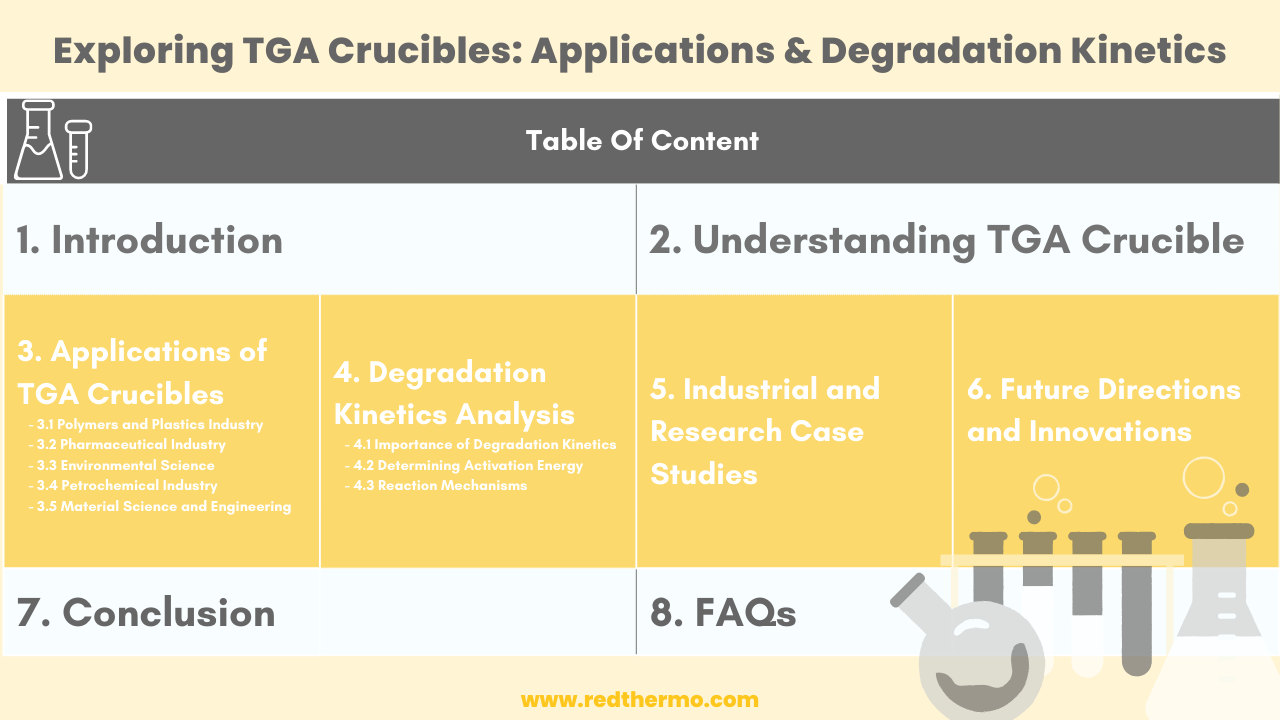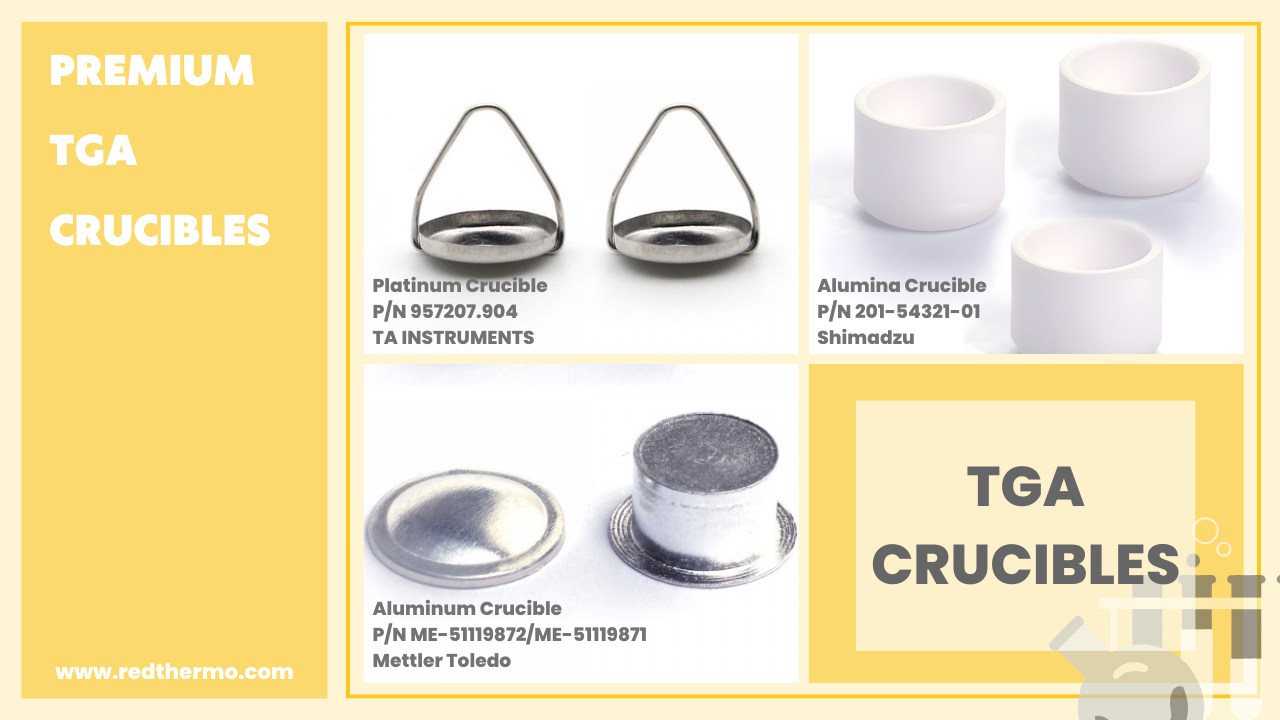Your cart is empty.
shop now
Your cart is empty.
shop now

Table of Content
1. Introduction | 2. Understanding TGA Crucibles |
3. Applications of TGA Crucibles - 3.1 Polymers and Plastics Industry - 3.2 Pharmaceutical Industry - 3.3 Environmental Science - 3.4 Petrochemical Industry - 3.5 Material Science and Engineering | 4. Degradation Kinetics Analysis - 4.1 Importance of Degradation Kinetics - 4.2 Determining Activation Energy - 4.3 Reaction Mechanisms |
5. Industrial and Research Case Studies | 6. Future Directions and Innovations |
7. Conclusion | 8. FAQs - FAQ 1: What is the significance of TGA crucibles in the polymer industry? - FAQ 2: How is degradation kinetics analysis useful in environmental science? - FAQ 3: Can TGA crucibles be used for studying pharmaceutical degradation? - FAQ 4: How does degradation kinetics analysis contribute to material science advancements? - FAQ 5: What are some future developments expected in TGA crucible technology? |
Thermogravimetric analysis (TGA) is a widely used analytical technique that measures the weight changes of a sample as it undergoes controlled heating or cooling. TGA crucibles are specialized containers used to hold the samples during the analysis. By monitoring the weight changes, researchers can gain insights into the thermal stability, composition, and degradation behaviour of various materials. The study of degradation kinetics, on the other hand, focuses on analyzing the rate at which a material degrades over time under specific conditions.
TGA crucibles are typically made from high-quality materials such as alumina, platinum, or aluminum. These materials are chosen for their resistance to high temperatures and chemical reactions. The crucibles are designed to withstand the rigorous conditions of thermal analysis experiments while maintaining their structural integrity. They come in different shapes and sizes to accommodate various sample volumes and analysis requirements.

The polymers and plastics industry extensively relies on TGA crucibles for quality control, product development, and research purposes. TGA analysis helps determine the degradation temperature, stability, and thermal behaviour of polymers, which is crucial in designing durable and high-performance plastic products. Additionally, TGA crucibles are employed to study the effects of additives, fillers, and processing conditions on polymer properties.
In the pharmaceutical industry, TGA crucibles find applications in drug stability studies and formulation development. By subjecting drug compounds to thermal analysis, researchers can evaluate their stability under different temperature conditions. TGA analysis aids in identifying potential degradation pathways, which is vital for ensuring the efficacy and safety of pharmaceutical products.
TGA crucibles play a significant role in environmental science research, particularly in studying the thermal decomposition of organic and inorganic materials. This analysis helps assess the environmental impact of substances such as waste materials, pollutants, and hazardous chemicals. By understanding the degradation kinetics of these substances, scientists can develop strategies for waste management, pollution control, and remediation.
In the petrochemical industry, TGA crucibles are utilized to analyze the thermal behavior and stability of petroleum-based products. This includes studying the degradation of fuels, lubricants, and polymers used in the industry. TGA analysis provides valuable insights into the performance and durability of these materials under different temperature conditions, enabling better formulation and optimization of petrochemical products.
TGA crucibles are widely employed in material science and engineering research. They are used to analyze the thermal properties, degradation kinetics, and stability of various materials, including metals, ceramics, composites, and nanoparticles. This information is crucial for designing new materials, optimizing manufacturing processes, and assessing the performance of materials in specific applications.
Degradation kinetics analysis is essential for understanding the rate at which a material degrades over time. It provides valuable information about the reaction mechanisms, activation energy, and lifetime expectancy of material under specific conditions. By studying the degradation kinetics, researchers can predict the long-term behaviour of materials, identify potential issues or weaknesses, and develop strategies to enhance their performance and durability.
One of the key aspects of degradation kinetics analysis is the determination of activation energy. Activation energy represents the energy barrier that must be overcome for a degradation reaction to occur. By measuring the weight loss of a sample at different temperatures, researchers can calculate the activation energy using various mathematical models. This information is vital for understanding the stability and thermal behavior of materials.
Degradation kinetics analysis also helps unravel the reaction mechanisms involved in the degradation process. By studying the weight loss patterns over time, researchers can identify the different stages or steps of degradation and the corresponding reactions taking place. This knowledge aids in understanding the degradation pathways, identifying potential degradation products, and developing strategies to mitigate degradation effects.
In recent years, numerous industrial and research case studies have demonstrated the practical applications of TGA crucibles and degradation kinetics analysis. For instance, in the polymer industry, TGA analysis has been used to optimize the formulation of flame-retardant materials by studying their thermal degradation behavior. In the field of environmental science, TGA crucibles have helped assess the thermal stability and degradation pathways of pollutants in soil and water samples. In material science, TGA analysis has contributed to the development of advanced materials with improved thermal properties and stability.
The field of TGA crucibles and degradation kinetics analysis continues to evolve, with ongoing research and innovations. Future developments may include the integration of TGA techniques with other analytical tools to gain more comprehensive insights into material behavior. There is also a growing interest in studying the degradation kinetics of biomaterials and renewable resources, as sustainability becomes a paramount concern in various industries. Additionally, advancements in TGA crucible design and material composition may lead to improved performance, higher temperature ranges, and increased durability.
Thermogravimetric analysis (TGA) crucibles and the study of degradation kinetics have proven to be invaluable in various industries and research fields. These tools allow researchers to understand the thermal behaviour and degradation characteristics of materials, enabling advancements in product development, quality control, and environmental analysis. The applications of TGA crucibles range from the polymer and pharmaceutical industries to environmental science, petrochemicals, and material science. By analyzing degradation kinetics, researchers can determine activation energy, understand reaction mechanisms, and predict material behaviour over time. Ongoing research and future innovations in TGA crucibles and degradation kinetics analysis hold promise for further advancements in understanding material properties and developing sustainable solutions.
TGA crucibles play a vital role in the polymer industry by enabling the analysis of thermal stability, degradation behaviour, and the effects of additives and processing conditions on polymer properties. This information helps in the formulation of durable and high-performance plastic products.
Degradation kinetics analysis assists environmental scientists in assessing the thermal decomposition and stability of organic and inorganic materials. This knowledge contributes to waste management strategies, pollution control, and environmental remediation.
Yes, TGA crucibles find applications in the pharmaceutical industry for studying drug stability and degradation pathways. This helps in ensuring the efficacy and safety of pharmaceutical products.
Degradation kinetics analysis provides insights into the rate of material degradation, reaction mechanisms, and activation energy. This knowledge aids material scientists in designing new materials, optimizing manufacturing processes, and assessing material performance in specific applications.
Future developments in TGA crucible technology may include the integration of TGA with other analytical techniques, such as spectroscopy, for comprehensive material analysis. There is also a growing focus on studying the degradation kinetics of biomaterials and renewable resources to address sustainability concerns. Advances in crucible design and material composition may lead to improved performance, extended temperature ranges, and enhanced durability.